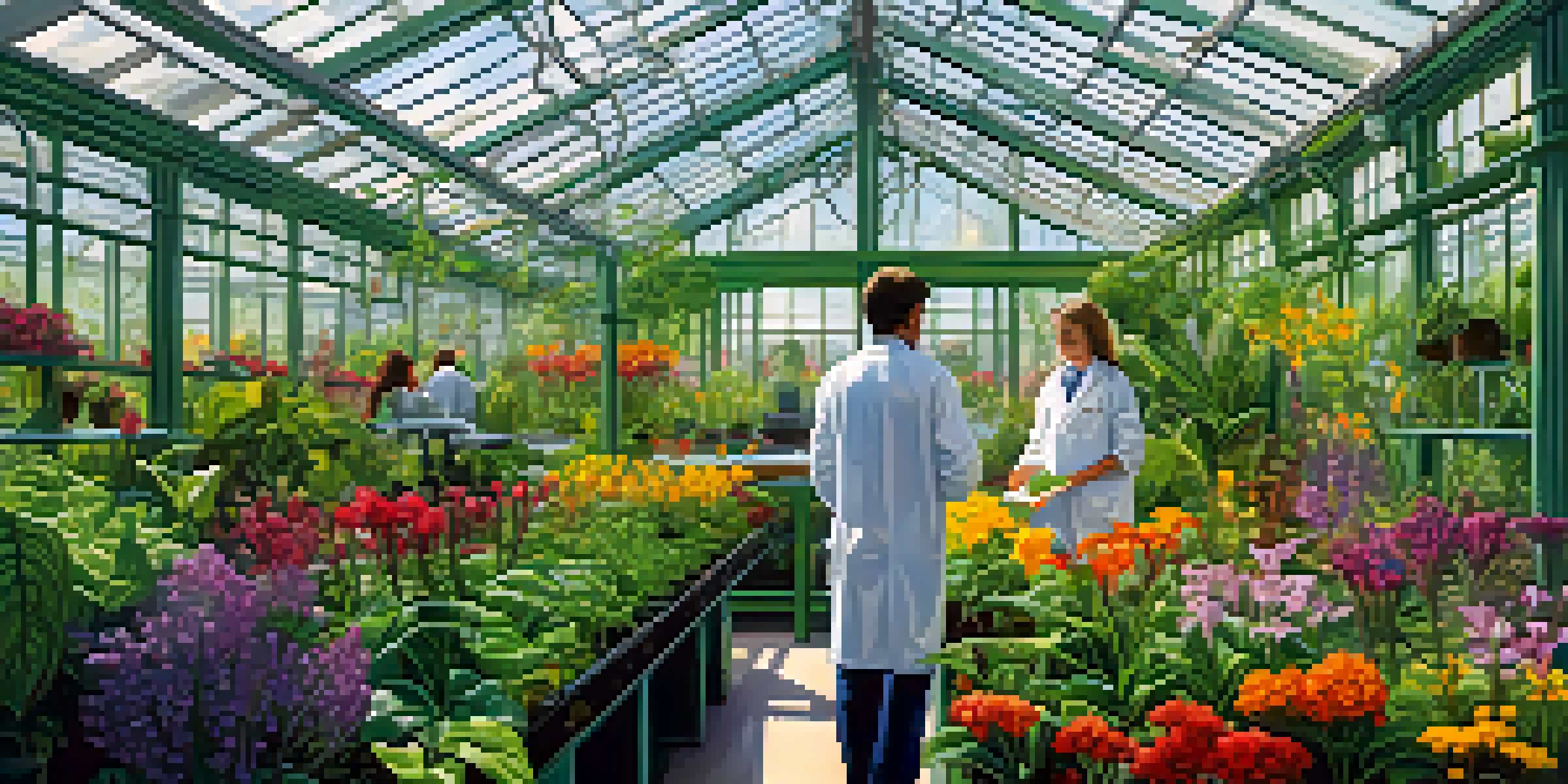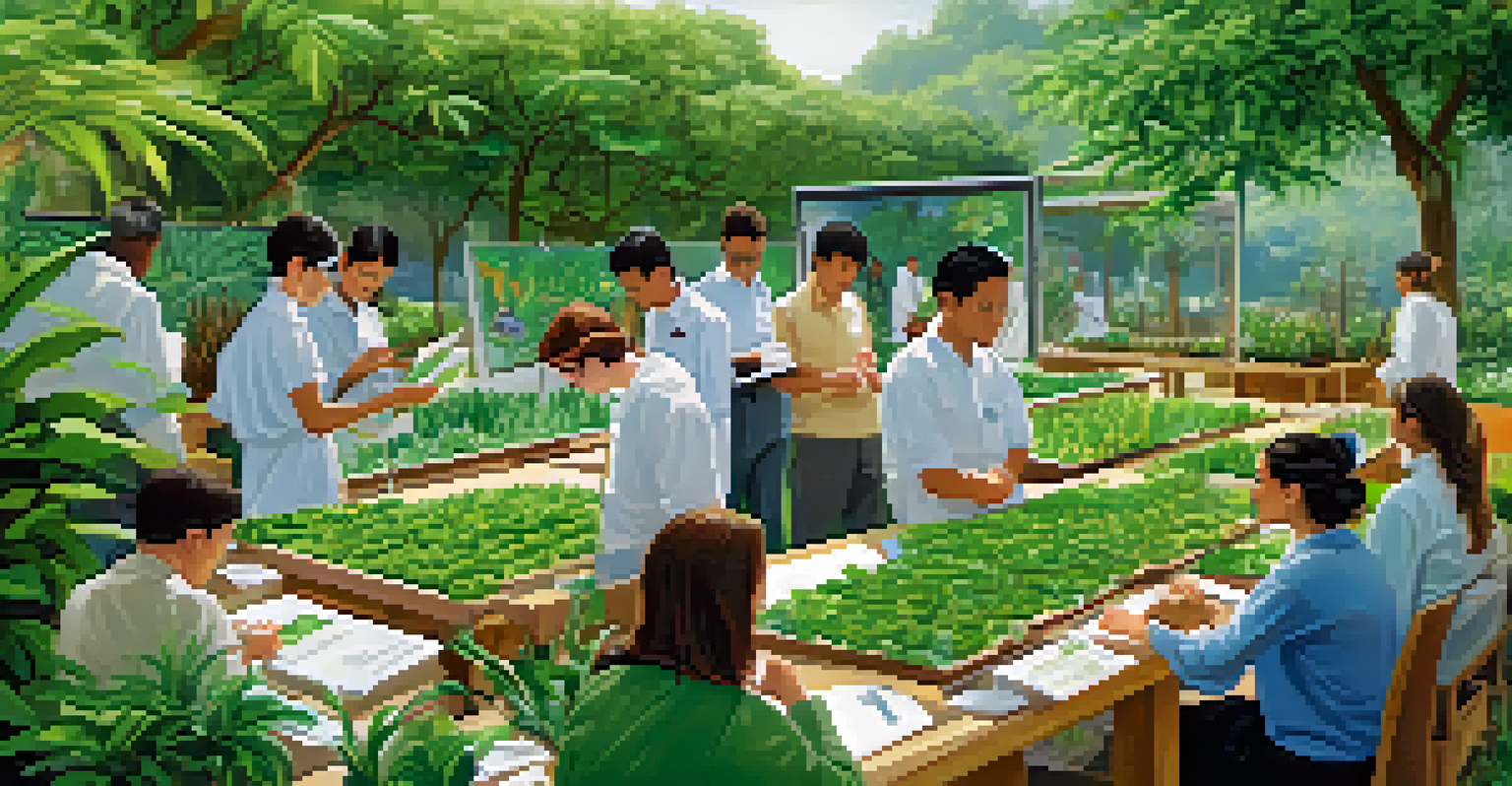The Impact of Plant Biotechnology on Biodiversity Conservation

Understanding Plant Biotechnology and Its Significance
Plant biotechnology refers to the use of scientific tools and techniques to manipulate plant genes. This innovative approach allows scientists to enhance desirable traits in plants, such as disease resistance or drought tolerance. By improving the genetic makeup of plants, biotechnology plays a crucial role in addressing agricultural challenges and ensuring food security.
Biotechnology is a tool that can help us address the challenges of food security and biodiversity conservation in an increasingly complex world.
The significance of plant biotechnology extends beyond agriculture; it also encompasses biodiversity conservation. As climate change and habitat destruction threaten various species, biotechnology offers solutions that can help preserve genetic diversity. For instance, scientists can use biotechnological methods to help endangered plant species adapt to changing environments.
Moreover, plant biotechnology can contribute to reforestation efforts by producing high-quality seedlings that are more resilient to disease and climate extremes. By focusing on the genetic diversity of native plant species, researchers can support ecosystems that are vital for overall biodiversity, making this technology an essential tool in conservation.
Enhancing Crop Resilience Through Genetic Modification
One of the most impactful applications of plant biotechnology is genetic modification, which allows for the development of crops that can withstand harsh environmental conditions. For example, scientists have created drought-tolerant varieties of staple crops, which are crucial for regions facing water scarcity. These crops not only help secure food supply but also minimize the pressure on natural ecosystems.

By increasing crop resilience, biotechnology also reduces the need for chemical inputs, such as pesticides and fertilizers. This shift can lead to healthier soils and reduced runoff into waterways, promoting a more balanced ecosystem. When farmers can grow food sustainably, it lessens the stress on surrounding biodiversity.
Plant Biotech Enhances Food Security
Plant biotechnology improves crop resilience and disease resistance, crucially addressing agricultural challenges and ensuring food security.
Additionally, resilient crops can thrive in diverse agricultural landscapes, supporting both farming and wildlife. By maintaining natural habitats alongside agricultural areas, we can foster environments where both crops and native species can thrive, illustrating a harmonious relationship between agriculture and biodiversity.
Restoration of Endangered Plant Species Using Biotech
Biotechnology plays a pivotal role in the restoration of endangered plant species that are on the brink of extinction. Through techniques like tissue culture and seed banking, scientists can propagate these plants in controlled environments, ensuring their survival. This method not only helps boost the population of rare species but also maintains their genetic diversity.
The future of conservation will depend on our ability to harness the power of biotechnology to restore ecosystems and safeguard biodiversity.
For example, scientists have successfully used tissue culture to propagate orchids, which are threatened by habitat loss and over-collection. By creating nurseries that produce these plants, conservationists can reintroduce them into their natural habitats, restoring balance to ecosystems that have been disrupted.
Moreover, the use of biotechnology allows for the study of the genetic makeup of endangered species, providing insights that can inform conservation strategies. By understanding the genetic diversity within these populations, conservationists can make informed decisions about habitat restoration and species management, ultimately contributing to the overall health of biodiversity.
Addressing Invasive Species Through Biotechnological Solutions
Invasive species pose a significant threat to global biodiversity, often outcompeting native plants and disrupting ecosystems. Plant biotechnology can offer solutions to manage these invasive species effectively. By developing genetically modified plants that can resist invasives or even suppress their growth, we can help restore balance in ecosystems.
For instance, scientists have explored the use of biocontrol agents, which are natural predators or diseases that can be introduced to control invasive species. By understanding the genetics of both the invasive and native species, researchers can identify the most effective biocontrol strategies, minimizing negative impacts on native biodiversity.
Biotech Supports Biodiversity Conservation
Through techniques like tissue culture, biotechnology helps restore endangered plant species and preserve genetic diversity in ecosystems.
Additionally, biotechnology can aid in monitoring invasive species by developing rapid detection methods. With early identification, conservationists can respond more effectively, preventing invasive species from taking hold and further threatening native ecosystems. This proactive approach highlights how biotechnology can be a valuable ally in the fight against biodiversity loss.
Promoting Sustainable Agriculture for Biodiversity Benefits
Sustainable agriculture practices are crucial for maintaining biodiversity, and plant biotechnology can enhance these practices. By developing crops that require fewer resources, such as water and fertilizers, biotechnology supports farming methods that are less harmful to the environment. This shift allows natural habitats to thrive alongside agricultural lands.
For example, precision agriculture techniques, enhanced by biotechnology, enable farmers to apply inputs more efficiently, reducing waste and environmental impact. This method not only supports crop yields but also protects surrounding ecosystems from pollution and habitat degradation.
Furthermore, sustainable agriculture promotes the use of cover crops and crop rotation, which can be optimized through biotechnological advancements. By improving soil health and preventing erosion, these practices protect local biodiversity and contribute to a healthier planet. Ultimately, the synergy between biotechnology and sustainable farming is vital for conserving our natural resources.
Educating Communities on the Benefits of Plant Biotechnology
Education plays a vital role in the successful implementation of plant biotechnology for biodiversity conservation. By informing communities about the benefits and potential of biotechnology, we can foster a greater understanding of its importance. This knowledge empowers individuals to support initiatives that utilize biotechnology for environmental protection.
Community engagement is essential, as local populations often have valuable insights into their ecosystems. By involving these communities in biotechnological projects, we can create tailored solutions that respect local knowledge while introducing innovative practices. This collaborative approach not only promotes conservation efforts but also strengthens community ties.
Sustainable Farming Through Innovation
By developing resource-efficient crops, plant biotechnology promotes sustainable agriculture that benefits both the environment and biodiversity.
Moreover, educational programs that highlight successful case studies of biotechnology in conservation can inspire other regions to adopt similar strategies. Sharing stories of positive outcomes can motivate individuals and organizations to embrace biotechnology as a tool for preserving biodiversity, ultimately leading to a more sustainable future.
Future Prospects: Integrating Biotechnology with Conservation Efforts
As we look to the future, the integration of plant biotechnology with conservation efforts is becoming increasingly vital. The challenges posed by climate change and biodiversity loss require innovative solutions that take advantage of scientific advancements. By combining traditional conservation methods with biotechnological tools, we can develop more effective strategies.
For instance, researchers are exploring genomic technologies that allow for the precise editing of plant genomes. This capability could enable the development of plants that not only thrive in changing climates but also support local ecosystems. The potential for creating resilient and diverse landscapes is immense, offering hope for conservation efforts.

Additionally, fostering collaboration between scientists, policymakers, and local communities will be essential in harnessing biotechnology for biodiversity conservation. By working together, we can ensure that the benefits of plant biotechnology are distributed equitably, leading to a healthier planet for future generations. The path ahead is promising, and the potential for positive impact is within our reach.